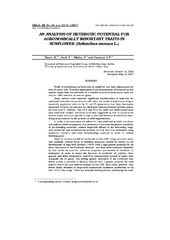Приказ основних података о документу
An analysis of heterotic potential for agronomically important traits in sunflower (Helianthus annuus L.)
| dc.creator | Škorić, Dragan | |
| dc.creator | Jocić, Siniša | |
| dc.creator | Hladni, Nada | |
| dc.creator | Vannozzi, G.P. | |
| dc.date.accessioned | 2021-04-26T18:20:57Z | |
| dc.date.available | 2021-04-26T18:20:57Z | |
| dc.date.issued | 2007 | |
| dc.identifier.issn | 1018-1806 | |
| dc.identifier.uri | http://fiver.ifvcns.rs/handle/123456789/550 | |
| dc.description.abstract | Study of inbreeding and heterosis in sunflower has been taking place for over 80 years now. Practical application of the phenomenon of heterosis in this species began after the discovery of a suitable source of cytoplasmic male sterility in 1969 and that of restorer genes. Many authors have reported significant manifestation of heterosis for seed yield and yield components as well. Also, the mode of inheritance of agronomically important traits in the F1 and F2 generations has been thoroughly examined. Positive correlations for yield have been established between parental lines and F1 hybrids. The GCA and SCA for yield and yield components have been well studied. Solutions have been suggested on how to increase the harvest index and sink capacity as well as the contributions of individual physiological parameters in the process of yield augmentation. In order to increase heterotic effects for seed yield and oil yield and direct and indirect yield components, it is necessary to increase the genetic variability of pre-breeding materials, achieve improved efficacy at the inbreeding stage, and streamline and accelerate the process of GCA and SCA evaluation using molecular markers and other biotechnology methods in order to achieve breeding goals. Seed oil content should be increased to over 55% using recurrent selection methods. Special focus in breeding programs should be placed on the development of high-oleic hybrids (>95%) with a high genetic potential for oil yield, resistance to the dominant diseases, and wide environmental adaptability that would be used for industrial purposes (production of biodiesel, or hydrogen). In order to extent the duration of sunflower oil stability, beta, gamma and delta tocopherols should be incorporated instead of alpha ones alongside the Ol genes. The exiting genetic variability of the cultivated sunflower makes it possible to develop hybrids with a genetic potential for seed yield of over 6 t/ha and seed oil content of over 55%. Most often, however, sunflower yields obtained in large-scale commercial sunflower production are in the 1.5-3.0 t/ha range. There are multiple limiting factors preventing the realization of the high genetic potential of this crop. Their removal will enable commercial sunflower yield to stabilize at levels of 4 t/ha and above. Diseases are the main limiting factor affecting sunflower production in all sunflower-growing parts of the world. Development of exotic germplasm through further use of wild sunflower species, distant hybridization and genetic transformations should be used to provide genes for resistance to all dominant pathogens and broomrape. Efficient breeding methods should be employed to increase sunflower tolerance of air and soil drought and salinity and to attain wider resistance to herbicides. | en |
| dc.publisher | Institut za ratarstvo i povrtarstvo, Novi Sad | |
| dc.rights | openAccess | |
| dc.source | Helia | |
| dc.subject | sunflower | en |
| dc.subject | breeding | en |
| dc.subject | yield | en |
| dc.subject | heterosis | en |
| dc.subject | oil quality | en |
| dc.subject | resistance | en |
| dc.subject | pathogens | en |
| dc.subject | drought | en |
| dc.title | An analysis of heterotic potential for agronomically important traits in sunflower (Helianthus annuus L.) | en |
| dc.type | article | |
| dc.rights.license | ARR | |
| dc.citation.epage | 74 | |
| dc.citation.issue | 46 | |
| dc.citation.other | 30(46): 55-74 | |
| dc.citation.spage | 55 | |
| dc.citation.volume | 30 | |
| dc.identifier.doi | 10.2298/HEL0746055S | |
| dc.identifier.fulltext | http://fiver.ifvcns.rs/bitstream/id/1408/547.pdf | |
| dc.identifier.scopus | 2-s2.0-77955958873 | |
| dc.type.version | publishedVersion |


